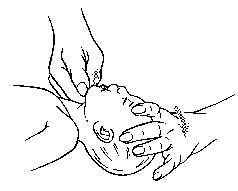These emergency procedures can sustain life if a child's breathing and/or heart have stopped. When respiration stops, the body begins to be deprived of oxygen, which can cause serious damage. Brain cells begin to die within four to six minutes if they are deprived of oxygen. CPR keeps blood and oxygen circulating in the body. By breathing into your child's lungs and pressing on his heart, you can maintain blood flow and oxygen/carbon dioxide exchange to the brain and other organs until he recovers or until emergency medical personnel arrive to take over.
The outlines of CPR procedures below are not meant to teach you everything in a time of crisis, but to be used as a refresher for a course on emergency first aid that includes infant and childhood CPR. The authors strongly recommend that anyone who cares for a child on a regular basis obtain such training. Courses are usually available through the Red Cross or a local hospital. Reading about the procedures cannot substitute for taking a course and practicing on a mannequin under the guidance of a qualified instructor. Further, these practices are constantly being researched and revised. Stay informed.
In addition to the usual mouth-to-mouth breathing, CPR can involve other procedures in special circumstances, such as giving CPR to a patient with a potential spinal-cord injury, mouth-to-nose breathing, mouth-to-nose-and-mouth breathing (as with an infant), and mouth-to-stoma breathing (a stoma is a surgically created opening in the body, such as a tracheostomy or laryngectomy). Only instruction and practice with an instructor in attendance will adequately prepare you to give CPR.
If your child loses consciousness, is not breathing, and /or loses his pulse, assess the situation quickly, call for emergency help, and initiate CPR in the manner described below that is appropriate to the child's age.
For an Infant Under One Year Old
Open the Airway
1. Hold your baby securely in the crook of your arm, face up.
2. Look to see if there is any foreign material in your baby's mouth. If you can see foreign material present, use your finger to remove it. Do not sweep your finger blindly through your baby's mouth.
3. Tip your baby's head back by pushing on his forehead. With your other hand, gently lift the bony part of the jaw (see Figure 3.2). This positioning opens the airway.
4. Check for a pulse on the brachial artery by placing the tips of your first two fingers on your infant's inner arm above the elbow. Check for breathing by putting your cheek close to your child's mouth to feel for a breath, and watch his chest to see if it is rising and falling as in normal breathing. If your child is not breathing on his own, take steps to restore breathing (see step 5). If your child has no pulse, initiate full CPR (go to step 9).
 Figure 3.2 Opening the Airway
Figure 3.2 Opening the Airway
Gently tip your child's head back and lift the bony part of the jaw.
Restore Breathing
5. With your infant's airway open as described above, cover his nose and mouth with your mouth, and give two slow puffs of air, with just enough force to cause your baby's chest to rise and fall as in normal breathing (see Figure 3.3). Be gentle.
 Figure 3.3 Rescue Breathing for an Infant
Figure 3.3 Rescue Breathing for an Infant
Cover your baby's mouth and nose with your mouth, and give two slow, gentle puffs of air.